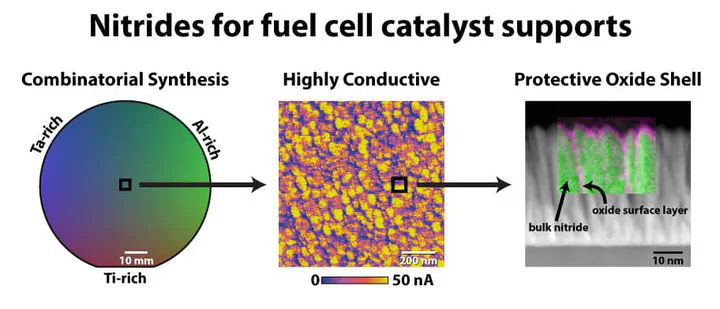Conductivity and Microstructure of Combinatorially Sputter-Deposited Ta–Ti–Al Nitride Thin Films
03 Jun 2015·
,
,
 ,
,
,
,
,
,
,
·
1 min read
,
,
,
,
,
,
,
·
1 min read
James R. O’Dea
Megan E. Holtz
Anna E. Legard
Samuel D. Young
Raymond G. Burns
Abigail R. Van Wassen
David A. Muller
Héctor D. Abruña
Francis J. DiSalvo
R. Bruce Van Dover
John A. Marohn

Abstract
Materials with long-term durability and electrical conductivity at low pH (<2) and high potentials (∼1.4 V vs RHE) are of great interest as catalyst supports in proton exchange membrane (PEM) fuel cells. We have evaluated Ta–Ti–Al nitrides for this purpose. Combinatorial sputter-deposition of Ta–Ti–Al nitride thin films allowed the composition of these films to be varied spatially over a substrate at ∼1 atomic %/mm, enabling the investigation of the conductivity and microstructure of these materials over a wide range of compositions. Conductive probe atomic force microscopy (cp-AFM) is shown to facilitate high-throughput screening of electrical conductivity as a function of composition. Local, tip-induced oxidation of the film indicated that films annealed in the presence of oxygen were most resistant to oxidation-induced losses of conductivity. Ti-rich compositions exhibited conductivities similar to carbon black and best retained their conductivity after tip-induced oxidation. Small amounts of Ti (∼20 atomic %) were sufficient to impart desired conductivities to compositions rich in Ta and Al, which without Ti exhibited insulating behavior. Electron energy-loss spectroscopy (EELS) imaging revealed the formation of a <2 nm oxide layer at the surface of the nitride films, which is expected to make these materials more durable. Remarkably, high conductivities were observed in the presence of this oxide layer. Segregation of elements was observed at sub-10-nm length scales, yet mapping the lattice constant of the film with X-ray diffraction showed that the majority phase is a well-mixed alloy with a lattice constant that varies smoothly over the entire range of compositions. The rock-salt structure was observed at all compositions except those with high levels of Al.
Type
Publication
Chemistry of Materials
Supporting information available here.